
From Rural Digital Divides to Local Solutions
The road to Garrett County, Maryland
Thick snow flurries fell on the night that my colleague Mark Hoelscher, then Brookings’s resident photographer, and I left Washington, D.C., driving northwest on Interstate 270 toward Garrett County, Maryland. The trip, which is normally three hours, took five given the blinding and hazardous weather conditions in the Allegheny Mountains. Garrett County is wedged between Pennsylvania to the north and West Virginia to the west and the south. While the estimated county population is around 29,000, the county has a land area of 647 square miles and a population density of only 47 people per square mile. Garrett County residents are predominantly white with a median household income of $49,619; 12 percent of residents fell at or below the poverty line in 2010. Most of the residents have at least a high school degree. And, more than half of the county residents over the age of 16 work in the more than 900 employer firms in the county with the largest industries being health care and social services. Approximately 2,000 individuals reported being self-employed or an independent contractor, according to the 2010 U.S Census.

The county seat is Oakland, the “great small town” that boasts about 1,900 residents. Oakland is about five to seven miles from Deep Creek Lake, the state’s popular tourist destination, and is also the hub for government buildings, local businesses, and community-based organizations. Oakland has a large Amish community, the oldest in Maryland. Established in the 1850s, the religious community is considered the “electric” New Order Amish due to its early adoption of public electricity in the home. Oakland’s Amish community has since embraced new technology, acknowledging its value in non-religious settings.
Getting robust broadband service to Garrett County has been challenging due to its location and rural topography. Eighty-two percent of residents own a computer, but only 73 percent have residential internet service. Moreover, the physical terrain and low-density population have largely led to lower-than-average broadband penetration and use. Because broadband infrastructure can be both expensive and technically challenging in rural areas, residents suffer the consequences of being digitally invisible in the information economy.
Garrett County resembles many other rural areas in the U.S. that are waiting for policymakers and incumbent internet service providers (ISPs) to move forward on expanding digital access in their communities. But what’s different about the county is the response of local stakeholders to fixing the challenges of being on the wrong side of the digital divide. My first photo essay focused on how residents of rural Staunton, Virginia, were defining and navigating the digital divide. In this composition, I’m highlighting the technical and community-based solutions that Garrett County is adopting to narrow digital disparities. One approach has been the county’s investment in and deployment of an innovative broadband solution incorporating TV white spaces that leverage the unused spectrum between television channels to provision broadband service, including Wi-Fi.
During our visit to Garrett County, I interviewed county residents, workers, and business owners, who underscored for me the need to make policy shifts in how we address the challenges of the rural broadband digital divide. These residents demonstrate that policymakers should consider investments in solutions to digital gaps that are being locally generated.
Setting the stage
Mark and I finally arrived in Garrett County in the dark around 3 a.m. and quickly checked into the LakeStar Lodge on a northern arm of mammoth Deep Creek Lake. Unbeknownst to us, we would wake up to the most beautiful landscape—a backdrop of mountains encircling a wide lake with a scrim of ice forming at the surface.
Later in the morning, we would meet our host, Barry Toser, co-founder of Declaration Networks Group (DNG), a small ISP serving rural areas in Virginia, Maryland, and Washington State. Barry and his co-founders, Bob Nichols and Keith Montgomery, bring over 100 combined years of expertise in telecommunications to the company. They developed the NeuBeam product to deliver high-speed broadband and voice services using a combination of advanced wireless technologies, including TV white spaces (TVWS).


Over the last nine years, the Federal Communications Commission (FCC) has worked to improve the use of TVWS by permitting mobile use on compatible devices and addressing interference with other devices. Last year, the FCC approved fixed and mobile compatible devices to operate in unused channels between television broadcast and wireless spectrum, which has enabled broadband service.
In 2018, DNG began a partnership with Microsoft to bring NeuBeam to more than 65,000 people in Accomack and Northampton Counties on the Eastern Shore of Virginia and Garrett County, Maryland, through 2021. Microsoft provides many resources as part of the partnership, while DNG performs a full range of services, from the initial sale and installation to troubleshooting and customer service. In 2019, the FCC awarded additional funds to DNG to deliver broadband service to an additional 2,454 homes in Garrett County over the next decade.
With less than three hours of sleep, Mark and I would follow Barry to our first interview. On this early morning, we would meet Jonathan Yoder, a local farmer and longtime county resident. We would come to find out that Barry and DNG’s Neubeam product were admired and treasured by the people in this community for bringing them broadband service.

More cows than people
The ride to meet Mr. Yoder was breathtaking, with mountains providing a natural frame to the surrounding water. When we finally pulled into his long driveway, which connected his home and farm, it looked like a postcard as snow flurries fell lightly upon a slim, bearded man who was waiting to greet us.
Jon quickly waved in our cars and brought us into his home. When we got inside, the smell of firewood greeted us. We met his family under the gaze of a large, stuffed deer head that up close looked still alive.
Jon was raised Amish before becoming a Mennonite at age six. His lineage includes a long list of farmers very well-known in the area. Compared to the Amish, Mennonites differ slightly from the Amish in their dress and adherence to traditional practices, such as using horse and buggies for transportation. Mennonites also tend to be less progressive in their use of technology, believing that it is a distraction from nature and not in line with their religious practices.
Our interview started with Jon sharing that “[t]his is mainly an Amish community so the technology is pretty limited. But as a farmer, we are on the backside of the curve, only until recently have we gotten good internet—thanks to Barry.”
Throughout our discussion, he also detailed the grunt work involved with farming and ended with a suggestion that technology alone will not replace the rudimentary tasks of his industry. “Now, you can work smarter, but farming is a competitive market and family farms are on the way out,” he asserted, making sure that I had background on his lifelong profession. In addition to providing dairy and other produce, Jon Yoder’s farm also owns Heidi’s Bakery and Café, located on site.
Yoder’s dairy farm has not been insulated from the economic shifts and downturns in the farming industry. Since the early 20th century, farms have transitioned from labor-intensive wholesale production to smaller and more diversified businesses. The number of U.S. farms has sharply declined from 6.8 million in 1935 to approximately 2.05 million in 2017, according to the U.S. Department of Agriculture.
Technology is quickly becoming a differentiator in this industry as the next generation of agricultural innovation involves a collaboration of networked technologies, including the internet-of-things (IoT) sensors, GPS devices, and other broadband-enabled tools. Yet, for farmers like Jon Yoder, the promise of these resources and the future of precision agriculture—a combination of these applications—remains largely a dream because they still lack basic connection to the internet. As Jon explained:
Look, we are still trying to figure out how to use the technology. People talk about precision agriculture, which I think will be great. But, until Barry [and Neubeam] came along, I could see the last mile of internet from this window and it wasn’t coming to my farm.
DNG’s broadband service involves small-mesh networks that target specific access points on the farm, while providing general broadband service to the house—all via TV white spaces. With larger farms both outnumbering and in some cases outperforming small agricultural businesses, bringing new or enhanced connectivity to rural industries is imperative. At a practical level, Jon summarized it like this:
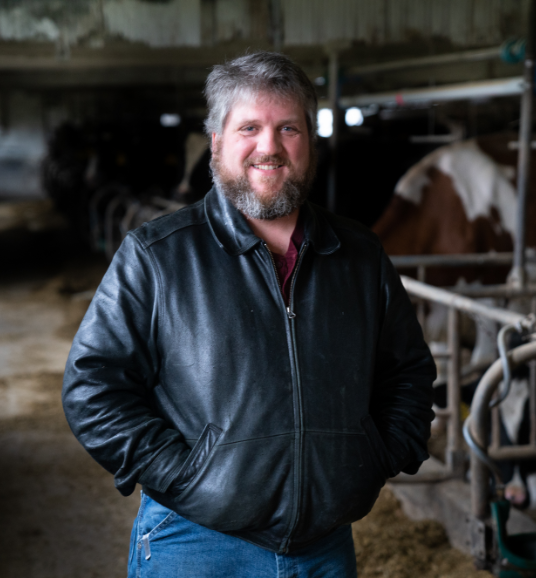
For businesses to survive in rural America, they will have to be connected. I need connectivity to order equipment right now, which helps me to make money and even get to the weather app, which helps me to decide my workflow. If the app tells me that it’s going to rain? I may not mow today.
Jon shared some familiarity with the broadband solution being offered: “[t]his TV white space model is definitely one of many directions that rural areas can take to solve this problem.” He continued his commentary by highlighting the lack of options for rural areas:
We definitely need more options out in rural America—whether it be cellular, satellite or fiber. The key things that matters to most of us farmers are cost, speeds, and data caps. [Now,] I can work at home and I can do some of things that I just wasn’t able to do, like ordering equipment and finishing paperwork. And, it’s affordable which matters.
Helping farmers stay current on their business needs is one of many critical reasons for advancing any and all rural broadband solutions. The conversation on Yoder farm reminded me of a different visit to Lincoln, Nebraska, where Bruce Rieker, the lead director of government relations for the state’s Farm Bureau, shared:
It’s simple. A farmer can buy a million-dollar tractor with all the bells and whistles enabling it for broadband use. But without high-speed access, that farmer just bought another tractor.
Farming may be one of the last industries that has not been fully disrupted by technology like the transportation and retail sectors. As policymakers push bold and broad agendas around rural broadband deployment, solutions that get to the core of farmers’ realities, while futureproofing their business for technological change, are important. The technology also needs to meet these farmers where they are, whether at the high- or low-end of broadband connectivity, making its application more useful and cost-effective.
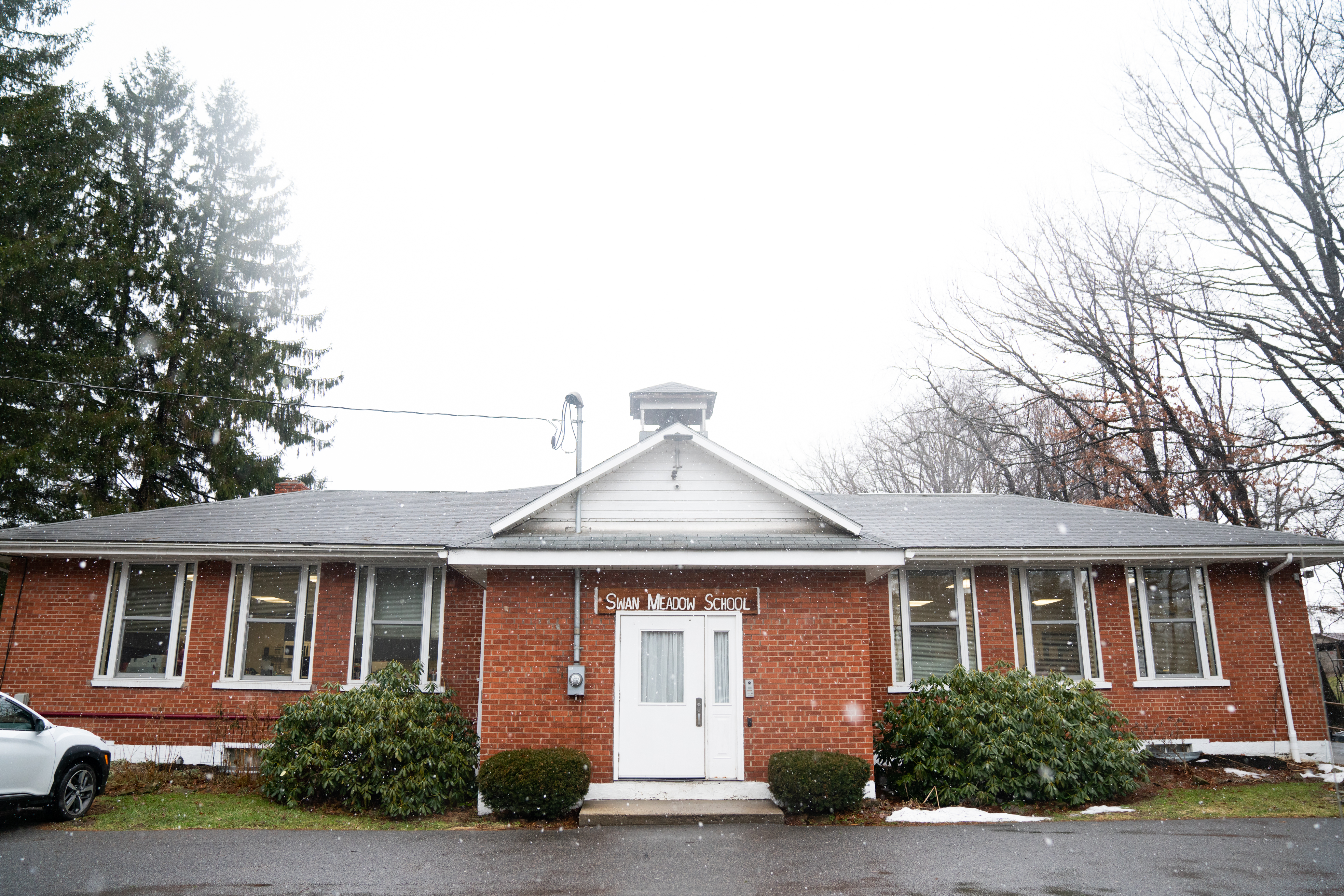
More books than laptops
After leaving the farm, we drove about 25 minutes before pulling up into the gravel parking lot of the Swan Meadow School in the Gortner community. The historic three-room school was built in the 1890s for local farming families of different faiths. The school was rebuilt in 1958 and again in the nineties as it transitioned from one-room to three classrooms with approximately nine staff and faculty.

“Welcome to Swan Meadow,” Arlene Lantz, the school’s computer lab supervisor and only math teacher, greeted us enthusiastically.
Fifty-one students attend the school in grades K-8. According to state test scores, 85% of students are proficient in math and 90% in reading. In 2018, the school received the Sustainable Maryland Green Award for helping students facilitate better relationships with the environment. In 2019, Swan Meadow students on the Garrett County FIRST Robotics team qualified for the world championship. Students from the broader county also won first place in the Maryland State FIRST Lego League Championship. “We have an extensive robotics program here at the school and in the county. We have two students on the team who are building robots and going to competition. This all happens after school and with technology,” Arlene commented.
The school is also predominantly Amish. “We largely have Amish and Mennonite students here,” Arlene shared. “We now have a few English students, but that’s just recently.” (“English students” refers to all non-Amish.) “We use technology in the school,” Arlene continued. “We encourage positive behaviors and distribute rewards for them. Many of these students do not have technology at home due to their religion so we use it as a teaching tool. We teach the students to be collaborative when using them and we incorporate the technology into projects.”
Arlene talked about the sensitivity in using technology within the school given the community’s religious beliefs. She emphasized the importance of structuring technology into classroom lessons that help her students problem-solve. Swan Meadow bolsters these efforts with a laptop cart that is brought into each of the three classrooms daily.
“Prior to Barry coming in and helping us, we didn’t have a quality broadband connection,” Arlene told me. “We use our harvest sale to buy laptops where we sell baked goods, produce from local farms, and other artisan items. But what we needed was internet for the 29 laptops that we have.”
At Swan Meadow, a 5 GHz radio activated through mounted antenna on the side of the school brings reliable broadband service into the facility.
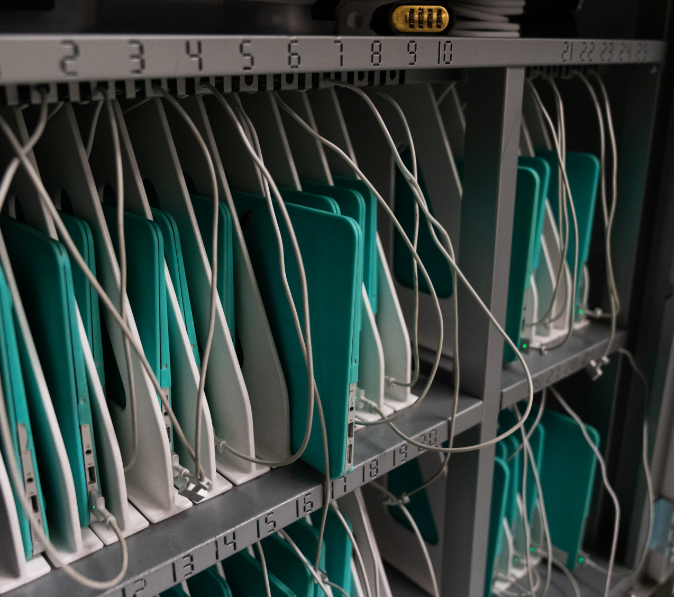
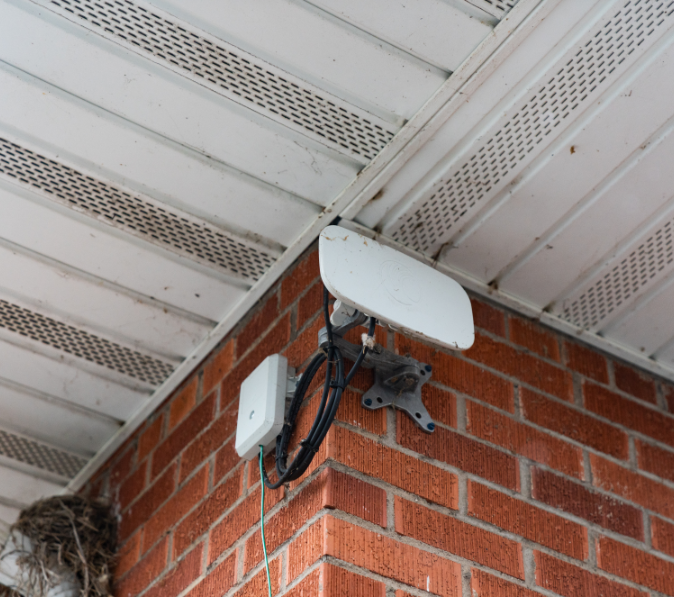
“There are not too many places that students can go to get internet in the county—the libraries, McDonald’s, or Heidi’s Café. But the learning and teaching experiences have been enhanced because of the broadband connection,” Arlene explained. “Don’t get me wrong, we are still reading books here. Kids work hard here at school so they do not need the technology at home. We are pushing it here for them.”
While most of the Amish students will ultimately return to work in their family businesses—primarily woodworking or textiles—local educators want to guarantee that these students understand the transformative power of new technology. “Most of our students will stay in the community,” Arlene said. “But my goal is to make sure that they understand what’s happening in the world around them.”
Arlene’s aspirations for her students surface one of the motivations behind the federal agenda to connect rural communities, which is to address widening educational access disparities. While both Congress and the FCC have passed recent directives to expand funding for these areas, schools like Swan Meadow will have to wait for that support, which makes TV white spaces both appealing and timely.
More needs than services
Social service agencies, like schools, are in similar predicaments as they attempt to disrupt the analog models traditionally used to work with their clients. As mentioned, the geography of Garrett County complicates its ability to immediately provide social services to residents. About 14% of residents in the county live in poverty, most of them children. We heard this firsthand from Gregan Crawford, who leads strategic initiatives at the Garrett County Community Action Center (the Action Center), which is a few miles away from the school in Oakland, the county seat.
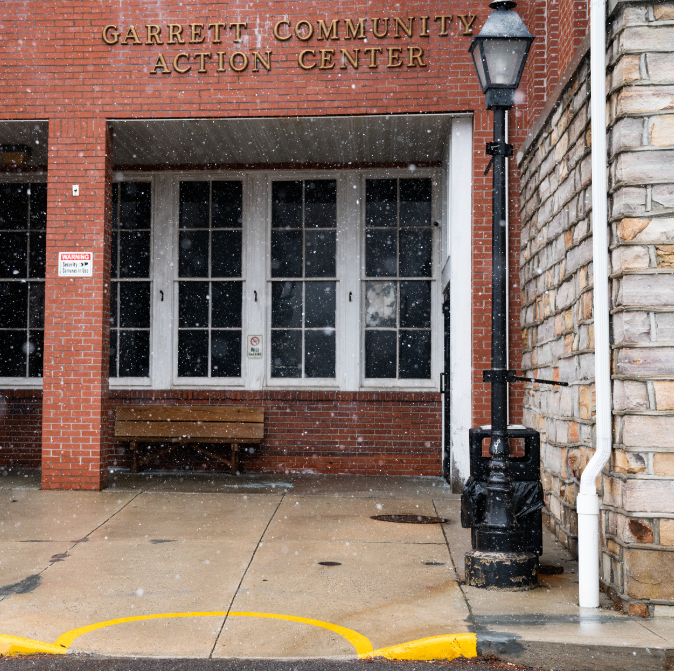

Gregan has lived in the county since 1989, and his role is to make sure the agency is effectively reaching county residents. Seated next to him is Daphne Gooding, who volunteers at the Action Center.
Daphne is a former welfare recipient who knows social services through her personal experiences. She is also familiar with the transformative power of technology, dating back years ago when she personally benefitted from it. “I lived in subsidized housing,” she mentioned. “I know what it’s like to be always trying to figure things out until I was exposed to computers and the internet.”
The Action Center is a one-stop shop, ensuring that residents have access to food, shelter, and other forms of assistance. The challenge for their caseworkers is that most residents do not have reliable transportation to make it into Oakland and there is no ridesharing service. “People often do not have working vehicles to travel to here,” Gregan explained. “So, we have to send our people to them—which could be a two-hour drive in the most rural parts of the county.” Even when his caseworkers make it to the client’s home, they return to the office to enter the data into the computer and then go back out to the location to confirm that the information is correct.
Since poverty already makes it difficult for residents to own a car, they are even more limited in joining a ridesharing business, like Uber or Lyft. Daphne connects this point to the lack of available and affordable broadband service:
Because people often do not have working vehicles, they can’t even participate. There are lots of places in the county where you can’t use a cell phone. The only option is satellite, but it’s expensive. And, the data caps. You watch ten YouTube videos and your data is done.
Places like Garrett County have come to rely upon partnerships with companies like Declaration Networks Group. “From a training perspective, being connected to the internet allows you to walk into any door when you need work. From a recovery perspective, we can develop better prescription management plans for those addicted to opioids,” shared Greg.
Opioid addiction has hit Garrett County hard, resulting in a recent $1.1 million federal grant awarded to a range of local providers to quell the epidemic locally and support recovery efforts. While the state of Maryland is battling increasing rates of illegal drug use and drug-related deaths overall, state lawmakers have introduced new initiatives targeted at harm reduction, including shields against criminal prosecution when reporting overdoses and the administration of Narcan to treat overdoses. In rural communities like Garrett County, responses are harder to facilitate and manage due to the lack of a coordinated response between public services and distance from clients, which is quite common across similar rural communities.
Gregan reiterated the challenges of the county’s terrain. “We lack the build out of the last mile connectivity. It is costly to install fiber here so there’s lots of resistance to get it. We need more access to meet people where they are at.”
Daphne recalls how rural community technology centers used to provide community access. “We need more of these so if you are a low-income mother with five kids, you can get help where you live. For people who are in poverty, they need office skills. The kids need computer skills. It’s our job to make that connection.”
However, most social service organizations are still dependent on an “in line” versus “online” methodology, causing them to rely on a paper-based system to record and track services. Across the U.S., most government services are conducted in this manner, leaving similar counties unable to streamline services to create better efficiencies and outcomes for clients. Working with DNG, the Action Center piloted a new program that brought broadband access to subsidized housing since the county is the largest landlord in the area. Residents received broadband service for a small monthly fee and were not charged for equipment or setup. The pilot was funded by the Rural Maryland Council to further the necessary infrastructure throughout the county.
Policymakers often look to wholesale solutions, whether through large appropriations to municipalities or companies on the side of massive deployment in rural areas. While federal dollars are also spent to automate systems that qualify, track, and report on households, these systems fail to account for the desperate end-to-end client services needs of agencies like the Action Center. “We need technology that is right for our tool kit,” Gregan shared. “Before Barry and DNG, we were challenged. TV white spaces can definitely be a tool because what we have now doesn’t work.”
Customizing the technology to the needs of rural areas can offer more valuable applications. In Garrett County, the Action Center will also deploy local kiosks throughout communities to better connect residents to services. For the Amish, this could be beneficial since they tend to stay clustered within their own communities.
What became evident in most of my conversations was the value of public and private partnerships, including all levels of government, industry, along with community-based organizations that are serving county residents. While increased investment in wholesale rural infrastructure projects is a start, Gregan summed it up this way: “In the end, it’s all about the people. We need to build a sustainable pathway and plan for them to access broadband.” That may require an immediate local solution that can deliver broadband services.

More requests than resources
Our visit to the Action Center left me thinking about how important it is to accelerate technology access not just for farmers, teachers, and case managers, but also for business leaders without an online connection who are digitally stuck and limited to analog experiences.
Our final visit was to My-O-Tire auto shop, where owner Josh Sines welcomed us with the first statement from his mouth was, “Bring me more Barrys!” Josh grew up in the county and his wife, who grew up two towns away, decided that they would never leave. Thanks to the NeuBeam product, Josh’s wife telecommutes to her job in Boston, Massachusetts.

Like the others, Josh shared glowing compliments of the broadband service.
In my business, you have no choice but to get things done. We [used to be] slow [to get online]. I had to go through every manual to find the right tire for a customer. Now, I can go online and just like that, it’s ordered. Because of Barry, there are fewer people on the edges where there was no service.
Part of the challenge in bringing connectivity to rural areas is the ability to serve the “edge of the edges,” where no facilities exist or the return-on-investment is too uncertain for incumbent internet service providers. To assist with sales efforts, DNG offers a $25 credit for referrals. Barry told me that over 20% of his company’s business is word of mouth in the county. On this point, Josh compared his relationship with with his ISP to an ice cream stand. “[Getting broadband] today is like an ice cream stand. If one of the salespeople knocks on my door, I may not bite. But, if everyone is at the counter, I may say there’s something to this.
Growing up in Garrett County before broadband was simple for Josh.
When I was growing up, we didn’t have cable or antennas that worked. We played in the woods. We connected with friends and got together. Garrett County is still a bubble like this and what’s happening in D.C. won’t get here in about six months. But, when [online] access increases, the lag decreases. It can help us here.
The concept of risk is not normally expressed in federal broadband proposals. More often, words that include certainty or reliability are criteria for federal funding. But as I learned from my visit to Garrett County, taking risks on local solutions and large scale federal strategies are the ingredients to advancing digital access in rural areas.
Driving more solutions to rural America
In September 2019, the FCC added to its previous rural investments by authorizing $112.2 million over the next decade through the Connect America Fund (CAF), projecting a reach of 48,000 underserved households and businesses in a variety of midwestern and western states. Prior to this, the agency awarded $4.9 billion to 171 local wireless carriers over the next ten years. Through a subsidized model, the funding will provide high-speed wireless access to more than 450,000 homes that are in high-cost rural areas. The agency plans to announce more awards as part of its effort to address the rural divide.
One month later, U.S. Representatives Antonio Delgado (D-N.Y.), Rodney Davis (R-Ill.), and Abigail Spanberger (D-Va.), along with 46 other House members, circulated a bipartisan letter to elevate the funding need for digital infrastructure in rural areas. The letter specifically called for increased funding to the U.S. Department of Agriculture’s Rural e-Connectivity Pilot Program (ReConnect), which supports partnerships for local officials interested in expanding high-speed internet to their respective communities. The projected implementation of this bill would be in 2020 to ensure that it is in the national budget. Signers of this bipartisan letter also called for increased support to the Farm Bill loan and grant program. Since this call to action, Delgado has also introduced the Rebuild Rural America Act, which would establish a flexible grant program for broadband access projects.
Ahead of the 2020 presidential election, several prospective Democratic candidates issued proposals targeted to narrowing rural broadband gaps. Democratic frontrunner, former vice president Joe Biden has put forth an infrastructure proposal that includes a $20 billion investment in rural broadband infrastructure and other programs that promote rural access. Republican incumbent, President Donald Trump, includes rural broadband as part of his broader infrastructure proposal, which was also a 2016 campaign promise that was stalled in the current Congress. While these various referenda on rural broadband demonstrate growing concerns, they also point out the disparate funding directions and approaches happening at the federal and state levels.
Further, some of these funding mechanisms still tend to favor specific technologies. Just recently, the FCC adopted a report and order approving the use of TVWS, both fixed and mobile in unused channels, ch. 37, guard bands between broadcast and wireless spectrum and between uplink and downlink spectrum in the 600 MHz band. Such actions will allow for more TVWS deployment like that in Garrett County and accelerate broadband access in rural communities. But the expansion of TVWS as a potential solution to close the digital divide in rural areas will require more unlicensed and available mid-band spectrum, which has become quite scarce among providers.
More access to fiber will be necessary to make these networks effective. Further, how we serve the “edge of the edges,” and especially those rural areas and local broadband companies that do not qualify for streamlined funding will need to be creatively addressed.
Another takeaway that should resonate from this narrative of Garrett County is that public-private sector partnerships matter. Declaration Networks Group successfully sought and won the CAF grant to subsidize their undertakings in the county. In September 2015, Garrett County and DNG entered into a long-term relationship that established funding for the deployment of a state-of-the-art broadband network infrastructure to deliver high-speed internet services to unserved and underserviced homes and businesses. The initiative was jointly developed by Garrett County and the Appalachian Regional Commission, which both committed grant funding to the effort. A corporate partnership was also established with Microsoft’s Airband Initiative to scale their technical solution, making it easier to deploy. When asked about these layers of partnership, Barry once again highlighted the importance of partnerships between government and the private sector: “[p]artnerships and government funding sources are a key to our success. The grant and loan processes are challenging to complete, but they are certainly worthwhile ventures for our company.” Moving forward with programs and models that can replicate this type of cooperation may be effective in hard to serve, rural areas.
Relaxing some of the burdensome requirements on small to mid-sized telecommunications providers to compete in national programs should be part of the process to wire disconnected, rural communities, especially when the business case fails to compel other investments. Further, inserting more flexibility into existing programs for rural broadband or establishing new ones targeted to these types of innovative solutions can facilitate better outcomes in unserved and under-served areas. Finally, the focus should be less on the technology in rural America and more on the problems that these communities are trying to solve, which lends itself to a range of strategies for effective deployment.

Conclusion
That evening, Mark and I drove back to D.C. both overwhelmed and overjoyed by the enthusiasm of residents and business owners now digitally connected. While Garrett County government has some ways to go on getting everyone online, the individuals and businesses profiled in this essay accomplished a very small task of releasing people from being stuck in the new digital economy. In my forthcoming book, “Digitally Invisible: How the Internet is Creating the New Underclass” (Brookings Press, 2021), the populations and places lacking digital access are rapidly growing. It’s now up to policymakers and productive partnerships among government, the private sector, and civil society to get creative on approaches and be more courageous risk takers to ensure equitable digital access in rural America.